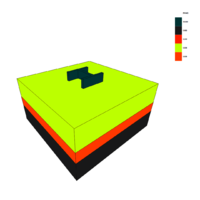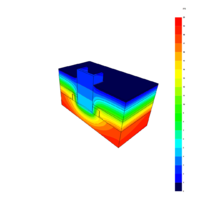3D Finite Element Analysis
Example - Analysis of column penetrating roof finishes
Our specialist analysers use finite elemental analysis software "TRISCO ver 13.w" developed by Physibel to undertake 3 dimensional thermal calculations.
Physibel have specifically designed this software for 3 dimensional thermal simulation and this produces constant and reliable analysis of constructions measuring heat transfer in rectangular objects.
TRISCO is a thermal analysis program for steady state heat transfer in three-dimensional rectangular objects consisting of different materials and submitted to different boundary conditions. The geometry is described with a list of rectangular blocks, which vertices lie on grid points of a rectangular grid. Materials and surface boundary conditions with different thermal properties are identified using separate colours. Each geometry block is part of either a material or a surface boundary condition region, and has a reference to one of these colours. Node boundary conditions with fixed temperature or power are possible, and can be placed in grid point locations. Also border face boundary conditions in the interface between two colour regions with fixed temperature or heat flux, or (material boundary conditions with fixed temperature or heat power density are possible.
After input of geometry and thermal properties a system of linear equations is calculated based on the energy balance technique, and solved using a fast iterative method. Possible non-linear problems are solved using of different cycles of adjusted linear systems.
We also incoporate Physibel's RADCON module for additional accuracy in analysis by calculating infrared radiation and convection in a more realistic manner than TRISCO alone.
RADCON is a program add-on module to calculate infrared radiation and convection in a physically more realistic way. The radiation is based on view factors, surface emissivities and surface temperatures. The convection is based on empirical laws.
Material properties such as thermal conductivity (λ values) used in these calculations have been taken from BS EN 12524:2000, BS EN ISO 10077-2:2003 or directly from the Physibel material database.
In addition specific product thermal conductivity values may be taken from suppliers’ own literature in the case of the material not being specifically included in the British Standards.
As with 2D BISCO the equivalent thermal conductivities of ventilated and unventilated air cavities are calculated by the software.
The results calculated using these methods are then incorporated into U value and condensation risk analysis as required.
See our download section for examples





